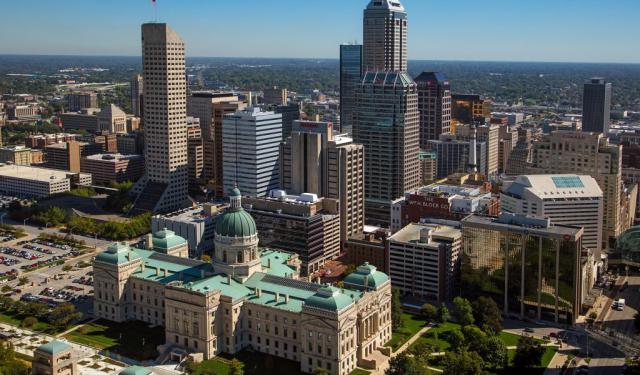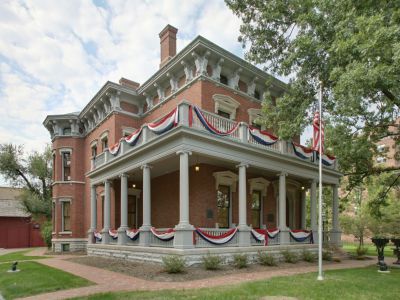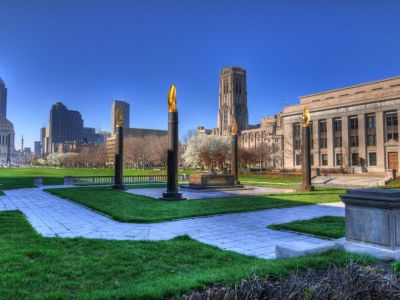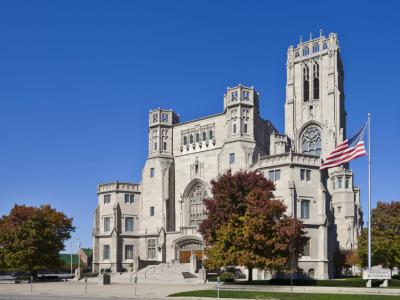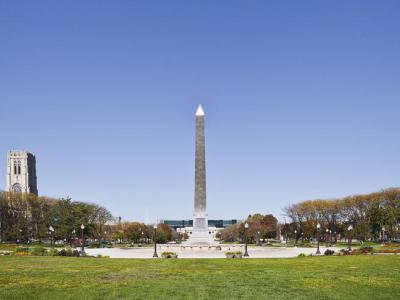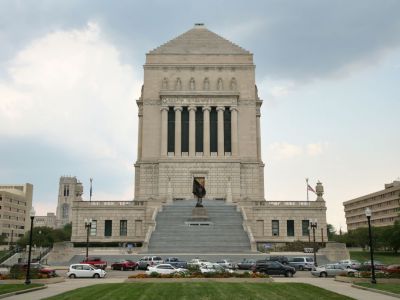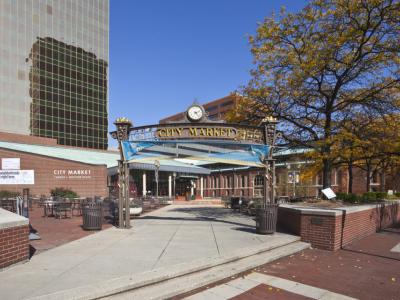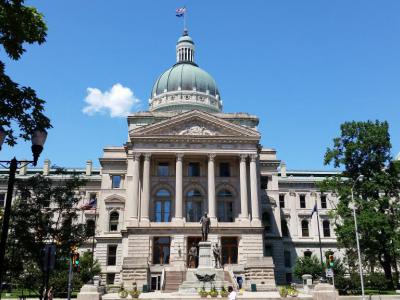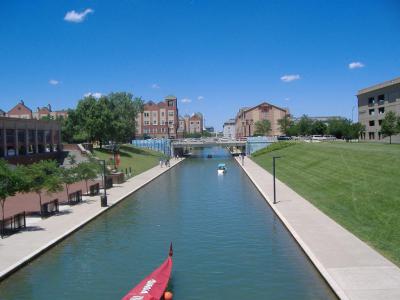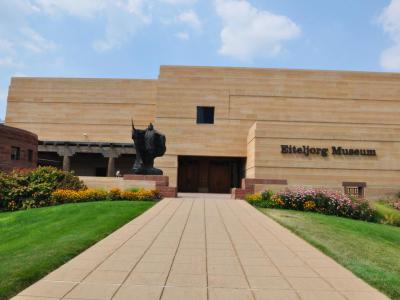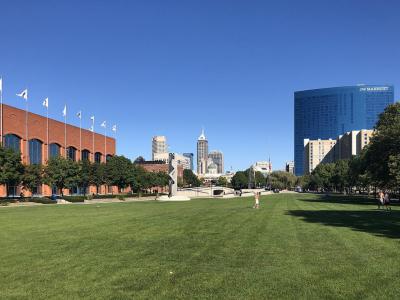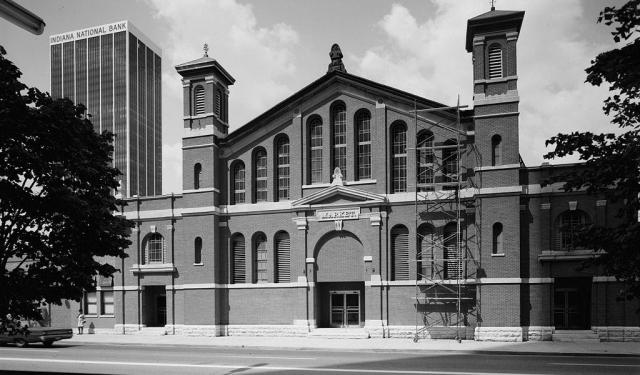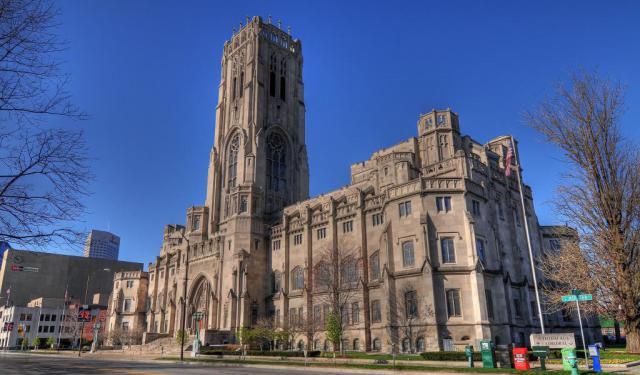Indianapolis Introduction Walking Tour (Self Guided), Indianapolis
The "Crossroads of America", Indianapolis (or Indy for short) is the capital of the US state of Indiana and the heart of the American Midwest.
The Indigenous people had lived in this area since as early as 10,000 BC before they relinquished their tribal land to the United States, in the Treaty of Saint Mary's, in 1818. The Eiteljorg Museum of American Indians and Western Art in the city preserves their legacy.
The name "Indianapolis" has its roots in Latin and Greek, combining "Indiana," which means "Land of the Indians," with "polis," the Greek word for "city." Founded in 1821, Indianapolis was intended to serve as the new state capital of Indiana, replacing Corydon. The decision was prompted by its strategic proximity to the White River and central location within the state.
Most of the city's early settlers were descendants of immigrants from northwestern Europe. During the Civil War, Indianapolis served as a hub for the Union. The towering Monument Circle at the heart of the city today commemorates Indiana's role in the Civil War.
At the turn of the 20th century, Indianapolis became a crucial manufacturing hub. Starting from the 1960s, it expanded into professional sports, saw its Downtown area revitalized, and new cultural districts set up.
The city boasts a wealth of historical sites and landmarks that offer a glimpse into its storied past. The Benjamin Harrison Presidential Site, a beautifully preserved 1875 Italianate mansion, was once home to the 23rd President of the United States.
Veterans Memorial Plaza and the Indiana World War Memorial pay tribute to those who served the country in the armed forces, while the Indianapolis City Market, a historic marketplace dating back to 1886, is a culinary destination offering a diverse range of food and artisanal products.
The Indiana State Capitol, with its neoclassical design, is another architectural gem and a center of the state government. Nearby, the Central Canal offers a picturesque place to stroll, jog, or take a scenic gondola ride.
Visitors who want to take full advantage of outdoor activities, complete with other attractions such as the Indianapolis Zoo and the Indianapolis Museum of Art, will want to include White River State Park in their itinerary.
Indeed, a city steeped in history and brimming with cultural attractions such as Indianapolis can satisfy multiple interests. So, don't wait! Come and experience the magic of this vibrant city yourself and make the most of your presence at the "Crossroads of America."
The Indigenous people had lived in this area since as early as 10,000 BC before they relinquished their tribal land to the United States, in the Treaty of Saint Mary's, in 1818. The Eiteljorg Museum of American Indians and Western Art in the city preserves their legacy.
The name "Indianapolis" has its roots in Latin and Greek, combining "Indiana," which means "Land of the Indians," with "polis," the Greek word for "city." Founded in 1821, Indianapolis was intended to serve as the new state capital of Indiana, replacing Corydon. The decision was prompted by its strategic proximity to the White River and central location within the state.
Most of the city's early settlers were descendants of immigrants from northwestern Europe. During the Civil War, Indianapolis served as a hub for the Union. The towering Monument Circle at the heart of the city today commemorates Indiana's role in the Civil War.
At the turn of the 20th century, Indianapolis became a crucial manufacturing hub. Starting from the 1960s, it expanded into professional sports, saw its Downtown area revitalized, and new cultural districts set up.
The city boasts a wealth of historical sites and landmarks that offer a glimpse into its storied past. The Benjamin Harrison Presidential Site, a beautifully preserved 1875 Italianate mansion, was once home to the 23rd President of the United States.
Veterans Memorial Plaza and the Indiana World War Memorial pay tribute to those who served the country in the armed forces, while the Indianapolis City Market, a historic marketplace dating back to 1886, is a culinary destination offering a diverse range of food and artisanal products.
The Indiana State Capitol, with its neoclassical design, is another architectural gem and a center of the state government. Nearby, the Central Canal offers a picturesque place to stroll, jog, or take a scenic gondola ride.
Visitors who want to take full advantage of outdoor activities, complete with other attractions such as the Indianapolis Zoo and the Indianapolis Museum of Art, will want to include White River State Park in their itinerary.
Indeed, a city steeped in history and brimming with cultural attractions such as Indianapolis can satisfy multiple interests. So, don't wait! Come and experience the magic of this vibrant city yourself and make the most of your presence at the "Crossroads of America."
How it works: Download the app "GPSmyCity: Walks in 1K+ Cities" from Apple App Store or Google Play Store to your mobile phone or tablet. The app turns your mobile device into a personal tour guide and its built-in GPS navigation functions guide you from one tour stop to next. The app works offline, so no data plan is needed when traveling abroad.
Indianapolis Introduction Walking Tour Map
Guide Name: Indianapolis Introduction Walking Tour
Guide Location: USA » Indianapolis (See other walking tours in Indianapolis)
Guide Type: Self-guided Walking Tour (Sightseeing)
# of Attractions: 11
Tour Duration: 2 Hour(s)
Travel Distance: 4.5 Km or 2.8 Miles
Author: DanaOffice
Sight(s) Featured in This Guide:
Guide Location: USA » Indianapolis (See other walking tours in Indianapolis)
Guide Type: Self-guided Walking Tour (Sightseeing)
# of Attractions: 11
Tour Duration: 2 Hour(s)
Travel Distance: 4.5 Km or 2.8 Miles
Author: DanaOffice
Sight(s) Featured in This Guide:
- Benjamin Harrison Presidential Site
- American Legion Mall
- Scottish Rite Cathedral
- Veteran Memorial Plaza
- Indiana World War Memorial
- Indianapolis City Market
- Monument Circle
- Indiana State Capitol
- Central Canal
- Eiteljorg Museum of American Indians and Western Art
- White River State Park
1) Benjamin Harrison Presidential Site (must see)
The Benjamin Harrison Presidential Site, formerly known as the Benjamin Harrison Home, is the meticulously preserved residence of the 23rd President of the United States, Benjamin Harrison. Located in the Old Northside Historic District of Indianapolis, this Italianate-style home was built between 1874 and 1875 and stands as a testament to Harrison's life and legacy.
The 16-room red-brick house was designed by architect Herman T. Brandt and features characteristic Italianate elements such as bracketed cornices and a three-story bay window. The interiors showcase exquisite oak-trimmed walnut staircases, butternut woodwork, and parquet floors. Harrison lived in the house for most of his life, except during his tenure as a U.S. Senator (1881–1887) and as President (1889–1893).
After Harrison's death, his widow, Mary Lord Dimmick Harrison, sold the property in 1939 to the Arthur Jordan School of Music, with the condition that it remain a memorial to the late president. Initially, the second and third floors served as a dormitory, while the first floor functioned as a museum. In 1974, after extensive renovations by the Arthur Jordan Foundation, the entire house was converted into a museum managed by the Benjamin Harrison Foundation.
The site became a National Historic Landmark in 1966 and now offers regular guided tours. Visitors can explore 10 of the 16 rooms, which are decorated in Victorian style to reflect the period of Harrison's residency. A remarkable 75% of the 3,700 artifacts displayed belonged to the Harrison family, including a library of 2,440 books.
Visitors to the site can immerse themselves in the story of a president whose home sparked a migration of Indianapolis' prominent residents to the north side, transforming the area into the historic district it remains today.
The 16-room red-brick house was designed by architect Herman T. Brandt and features characteristic Italianate elements such as bracketed cornices and a three-story bay window. The interiors showcase exquisite oak-trimmed walnut staircases, butternut woodwork, and parquet floors. Harrison lived in the house for most of his life, except during his tenure as a U.S. Senator (1881–1887) and as President (1889–1893).
After Harrison's death, his widow, Mary Lord Dimmick Harrison, sold the property in 1939 to the Arthur Jordan School of Music, with the condition that it remain a memorial to the late president. Initially, the second and third floors served as a dormitory, while the first floor functioned as a museum. In 1974, after extensive renovations by the Arthur Jordan Foundation, the entire house was converted into a museum managed by the Benjamin Harrison Foundation.
The site became a National Historic Landmark in 1966 and now offers regular guided tours. Visitors can explore 10 of the 16 rooms, which are decorated in Victorian style to reflect the period of Harrison's residency. A remarkable 75% of the 3,700 artifacts displayed belonged to the Harrison family, including a library of 2,440 books.
Visitors to the site can immerse themselves in the story of a president whose home sparked a migration of Indianapolis' prominent residents to the north side, transforming the area into the historic district it remains today.
2) American Legion Mall
The American Legion Mall helps give Indianapolis its reputation for being host to the second-highest number of monuments after Washington, D.C. Memorials commemorating World War II, Korea, and Vietnam are present. The national headquarters for the American Legion is also in this park. A nightly light show illuminates the monuments using a patriotic theme.
All of these monuments sit in an open lawn area that also features shade trees. The World War II Memorial features both limestone and granite, built in a half-circle. Indiana residents who paid the ultimate price in Korea and Vietnam are commemorated by name on the two cylinder-shaped memorials. Cenotaph Square celebrates the life of Cpl. James B. Gresham, Indiana's first World War I casualty.
Visitors looking for the name of a person commemorated on one of the memorials can access a weatherproof computer display. This database also lists the veterans who returned home, as well as POWs and MIAs.
All of these monuments sit in an open lawn area that also features shade trees. The World War II Memorial features both limestone and granite, built in a half-circle. Indiana residents who paid the ultimate price in Korea and Vietnam are commemorated by name on the two cylinder-shaped memorials. Cenotaph Square celebrates the life of Cpl. James B. Gresham, Indiana's first World War I casualty.
Visitors looking for the name of a person commemorated on one of the memorials can access a weatherproof computer display. This database also lists the veterans who returned home, as well as POWs and MIAs.
3) Scottish Rite Cathedral
The Scottish Rite Cathedral was designed by architect George F. Schreiber and plays an essential role in Scottish Rite Freemasonry's life in Indianapolis. This Neo-Gothic building was constructed between 1927 and 1929. Some of the highlights include a 212-foot tower with a carillon known as the "Singing Tower".
Sculptures depicted on the exterior include key figures such as King Solomon and King Hiram. Marble floors at the eastern and southern entrances feature centerpieces with the 12 Zodiac signs. These windows depict important symbolism to Freemasonry, as well as symbolism representing 1920s technology, as well as the liberal arts and sciences.
A ballroom with a floating floor and Elizabethan architecture also has a chandelier with over 200 lights. There is a Cathedral Gothic theater that features over 50 hand-painted backdrops. In addition to taking advantage of tours of this magnificent building, visitors can also stop at the Double Eagle Cafe for lunch.
Sculptures depicted on the exterior include key figures such as King Solomon and King Hiram. Marble floors at the eastern and southern entrances feature centerpieces with the 12 Zodiac signs. These windows depict important symbolism to Freemasonry, as well as symbolism representing 1920s technology, as well as the liberal arts and sciences.
A ballroom with a floating floor and Elizabethan architecture also has a chandelier with over 200 lights. There is a Cathedral Gothic theater that features over 50 hand-painted backdrops. In addition to taking advantage of tours of this magnificent building, visitors can also stop at the Double Eagle Cafe for lunch.
4) Veteran Memorial Plaza
The Veteran's Memorial Plaza dates back to 1930 and was known as Obelisk Square for much of its history. This plaza offers a fitting tribute to all of Indiana's veterans. The north end of the plaza hosts the American flag and all 50 state flags, demonstrating the importance of the veterans' contributions for all Americans.
This plaza's focal point is its obelisk, which attracts attention very easily at 100 feet tall. The obelisk's construction is Berwick granite, in an elegant tribute. This monument's shape is designed to represent the country's aspirations and hopes. Henry Hering created four tablets in bronze that represent education, religion, science, and law as the country's founding principles.
There is also a fountain in the plaza that spans an impressive 100-foot diameter. The materials used in the fountain's construction include pink marble from Georgia and terrazzo. All of these elements blend together to create a unique space for reflection.
This plaza's focal point is its obelisk, which attracts attention very easily at 100 feet tall. The obelisk's construction is Berwick granite, in an elegant tribute. This monument's shape is designed to represent the country's aspirations and hopes. Henry Hering created four tablets in bronze that represent education, religion, science, and law as the country's founding principles.
There is also a fountain in the plaza that spans an impressive 100-foot diameter. The materials used in the fountain's construction include pink marble from Georgia and terrazzo. All of these elements blend together to create a unique space for reflection.
5) Indiana World War Memorial (must see)
The Indiana World War Memorial exemplifies the design that was popular during the City Beautiful Movement of the early 20th century. This memorial's design is Neo-Classical, modeled after architecture used in the fifth century in ancient Greece. Ionic columns and a pyramidal dome help round out the interior's beautiful design.
Inside the building, visitors can explore three floors, with the Shrine Room on the third floor being one of the key attractions. There are 24 pillars of red Vermont marble that support the ceiling, a Swedish crystal Star of Destiny, and an Altar of Consecration to the American flag that serves as a place of remembrance.
The interior has a military museum that commemorates Indiana veterans, starting with the Battle of Tippecanoe all the way through modern conflicts. There is a gallery devoted to the USS Indianapolis, an AH-1 Cobra Attack Helicopter, and artifacts that include firearms, uniforms, documents, and photos.
Inside the building, visitors can explore three floors, with the Shrine Room on the third floor being one of the key attractions. There are 24 pillars of red Vermont marble that support the ceiling, a Swedish crystal Star of Destiny, and an Altar of Consecration to the American flag that serves as a place of remembrance.
The interior has a military museum that commemorates Indiana veterans, starting with the Battle of Tippecanoe all the way through modern conflicts. There is a gallery devoted to the USS Indianapolis, an AH-1 Cobra Attack Helicopter, and artifacts that include firearms, uniforms, documents, and photos.
6) Indianapolis City Market
The Indianapolis City Market is a historic public market founded in 1821 and officially opened in its current facility in 1886. The market building is a one-story, rectangular brick building trimmed in limestone. It has a front gable center section flanked by square towers. The market was listed on the National Register of Historic Places in 1974.
Today Indianapolis City Market features over 25 local businesses that visitors will enjoy supporting. These businesses offer everything from gourmet food to boutique-style gifts and even craft beers. One of the key highlights is the Original Farmer's Market, where visitors can easily find local in-season produce, herbs and spices, and baked goods.
Some of the food merchants where you can sample different cuisine choices include Gomez BBQ, Mauricio's Pizzeria, and Ameer Middle Eastern Cuisine. Additional merchants that visitors can enjoy include Circle City Sweets, Twenty Two Juice, and The Flower Boys. Visitors will also want to stop by the Tomlinson Tap Room, with a rotating selection of 19 craft beers from Indiana.
Visitors can also take advantage of regular special events, such as live performances. Regular public art installations take place at this market, many of which coincide with holidays. Multiple merchants will also often take part in sale events for holidays.
Today Indianapolis City Market features over 25 local businesses that visitors will enjoy supporting. These businesses offer everything from gourmet food to boutique-style gifts and even craft beers. One of the key highlights is the Original Farmer's Market, where visitors can easily find local in-season produce, herbs and spices, and baked goods.
Some of the food merchants where you can sample different cuisine choices include Gomez BBQ, Mauricio's Pizzeria, and Ameer Middle Eastern Cuisine. Additional merchants that visitors can enjoy include Circle City Sweets, Twenty Two Juice, and The Flower Boys. Visitors will also want to stop by the Tomlinson Tap Room, with a rotating selection of 19 craft beers from Indiana.
Visitors can also take advantage of regular special events, such as live performances. Regular public art installations take place at this market, many of which coincide with holidays. Multiple merchants will also often take part in sale events for holidays.
7) Monument Circle (must see)
This site was originally called the Governor's Circle because of its designation as the future site of the Indiana governor's residence. The Circle was a hub of community life from the town's beginning in 1821. A weekly market was held on the site from 1822 to 1824. As Indianapolis grew and developed during and after the Civil War, the area became a popular meeting place for mass gatherings, public rallies, and celebrations of wartime victories. In 1867 the site was cleaned up, fenced, and designated as the city's Circle Park.
In August 1875 George J. Langsdale, a newspaper editor of the Greencastle Banner, presented a plan for a memorial during the first reunion of Civil War veterans, which was held in Indianapolis. Construction on the monument, which began in 1888, took thirteen years to complete. The obelisk was completed in 1892, the main elements by 1894, and its final installations in 1901. In 1893 the circle was renamed Monument Place.
Today the Circle is surrounded by retail shops, studios for several local radio stations, the Hilbert Circle Theatre, home of the Indianapolis Symphony Orchestra, financial institutions, the Columbia Club - one of the oldest social clubs of Indiana, Christ Church Cathedral - a historic Episcopal church.
Monument Circle is the premier public gathering place in Indianapolis to commemorate notable events, including concerts, political demonstrations, and photo opportunities. Visitors can enjoy the sights of the Downtown area and beyond from the monument's observation level. This area can be reached by either climbing a staircase of 330 steps or taking an elevator that reaches the 290th step.
This area has a nightly light show that often changes with the seasons. All the lights used during the show feature synchronization to a theme that the Indianapolis Symphony Orchestra has composed for the event. This nightly light show starts at dusk and is available every night.
In August 1875 George J. Langsdale, a newspaper editor of the Greencastle Banner, presented a plan for a memorial during the first reunion of Civil War veterans, which was held in Indianapolis. Construction on the monument, which began in 1888, took thirteen years to complete. The obelisk was completed in 1892, the main elements by 1894, and its final installations in 1901. In 1893 the circle was renamed Monument Place.
Today the Circle is surrounded by retail shops, studios for several local radio stations, the Hilbert Circle Theatre, home of the Indianapolis Symphony Orchestra, financial institutions, the Columbia Club - one of the oldest social clubs of Indiana, Christ Church Cathedral - a historic Episcopal church.
Monument Circle is the premier public gathering place in Indianapolis to commemorate notable events, including concerts, political demonstrations, and photo opportunities. Visitors can enjoy the sights of the Downtown area and beyond from the monument's observation level. This area can be reached by either climbing a staircase of 330 steps or taking an elevator that reaches the 290th step.
This area has a nightly light show that often changes with the seasons. All the lights used during the show feature synchronization to a theme that the Indianapolis Symphony Orchestra has composed for the event. This nightly light show starts at dusk and is available every night.
8) Indiana State Capitol
The Indiana State Capitol, in its current building, goes back to 1888. The Capitol is one of the most popular attractions in Indianapolis, having welcomed visitors from all fifty states and many countries. An extensive renovation in 1988 helped mark the building's 100th anniversary and keep it in ideal condition for future generations.
This structure's style is Renaissance Revival, sharing some of the same influences as the U.S. Capitol. The grounds host flowering trees and shrubs, as well as memorials and monuments. All of the ceiling and wall designs are period, and there are two three-story atriums within the building.
The Capitol building features Indiana limestone construction. Noteworthy interior features include granite columns, marble floors and stairs, and a dome crafted of stained glass. Public tours are an excellent way to fully take advantage of everything that this building offers.
This structure's style is Renaissance Revival, sharing some of the same influences as the U.S. Capitol. The grounds host flowering trees and shrubs, as well as memorials and monuments. All of the ceiling and wall designs are period, and there are two three-story atriums within the building.
The Capitol building features Indiana limestone construction. Noteworthy interior features include granite columns, marble floors and stairs, and a dome crafted of stained glass. Public tours are an excellent way to fully take advantage of everything that this building offers.
9) Central Canal (must see)
Central Canal in Indianapolis is a canal dating back to the city's earliest days in the early 1800s. During the earliest times, the canal served as one of the city's primary trade routes. Today, the waterside area of the canal serves as a popular promenade. Walkers and sightseers, joggers, and bikers all use the walking space to take advantage of Downtown's most popular sights.
One of the popular attractions that the canal itself boasts is access to paddleboats available for rent. The location immediately west of the Indiana Museum is where visitors may rent these boats. When you take a paddle boat up the canal, you will see everything from a new perspective.
The area near the canal offers a vintage feel that you will appreciate, with antique lamp posts and beautiful flowering trees. You might even spot an outdoor concert going on while checking out this area. This canal is always worth your time.
In 1971 the canal was designated by the American Water Works Association as an American Water Landmark.
One of the popular attractions that the canal itself boasts is access to paddleboats available for rent. The location immediately west of the Indiana Museum is where visitors may rent these boats. When you take a paddle boat up the canal, you will see everything from a new perspective.
The area near the canal offers a vintage feel that you will appreciate, with antique lamp posts and beautiful flowering trees. You might even spot an outdoor concert going on while checking out this area. This canal is always worth your time.
In 1971 the canal was designated by the American Water Works Association as an American Water Landmark.
10) Eiteljorg Museum of American Indians and Western Art (must see)
The Eiteljorg Museum of American Indians and Western Art has extensive collections of Native American and Western art. Collections that are available represent a diversity of experiences, including women and different Native tribes. Artist talks and tours help visitors gain a deeper appreciation for the works currently displayed.
Native American collections include art and historical artifacts that represent the breadth of Native life. The Western art collection includes art from early modernists, and the contemporary art collection includes work from Native American artists. In the form of statuary, there is also a large collection of art found on the grounds.
This museum hosts a store where you can take home gifts and other items representing Native American or Western culture. Another excellent feature that the museum offers is a cafe where you can dine indoors or outdoors. The cuisine includes favorites prepared by in-house chefs to quality standards.
Native American collections include art and historical artifacts that represent the breadth of Native life. The Western art collection includes art from early modernists, and the contemporary art collection includes work from Native American artists. In the form of statuary, there is also a large collection of art found on the grounds.
This museum hosts a store where you can take home gifts and other items representing Native American or Western culture. Another excellent feature that the museum offers is a cafe where you can dine indoors or outdoors. The cuisine includes favorites prepared by in-house chefs to quality standards.
11) White River State Park (must see)
White River State Park is one of Indianapolis' most popular outdoor recreation areas. The park is a popular spot for art exhibitions, walks, and other outdoor recreation, and special events that are ideal for the entire family. Several of the most popular downtown attractions, such as the Indianapolis Zoo and Victory Field, fall within the confines of this park.
The Amphitheater at White River State Park regularly hosts headliner performances and performances from local acts. Permanent art exhibits are present in the park, including Prime Commonality that celebrates the connection between chimpanzees and humans, Harmony that emphasizes our balance with the world, and the wire-crafted American Bison sculpture. These cultural attractions help demonstrate how vital the arts are to this city.
The Urban Wilderness Trail offers abundant opportunities to encounter wildlife. One of the things that you'll find is the first sanctuary in Indianapolis for Monarch Butterflies. You can also easily spot bald eagles and beavers in this park.
The Amphitheater at White River State Park regularly hosts headliner performances and performances from local acts. Permanent art exhibits are present in the park, including Prime Commonality that celebrates the connection between chimpanzees and humans, Harmony that emphasizes our balance with the world, and the wire-crafted American Bison sculpture. These cultural attractions help demonstrate how vital the arts are to this city.
The Urban Wilderness Trail offers abundant opportunities to encounter wildlife. One of the things that you'll find is the first sanctuary in Indianapolis for Monarch Butterflies. You can also easily spot bald eagles and beavers in this park.
Walking Tours in Indianapolis, Indiana
Create Your Own Walk in Indianapolis
Creating your own self-guided walk in Indianapolis is easy and fun. Choose the city attractions that you want to see and a walk route map will be created just for you. You can even set your hotel as the start point of the walk.
Architectural Jewels
A number of unique constructions found throughout Indianapolis have given the city its inimitable identity. Many of them are registered on the National Register of Historic Places.
Some of the best local buildings are situated along the diagonal avenues coming from Mile Square, as per the city plan laid out in 1821 by Scottish-born architect Alexander Ralston (the one who participated in laying... view more
Tour Duration: 2 Hour(s)
Travel Distance: 4.6 Km or 2.9 Miles
Some of the best local buildings are situated along the diagonal avenues coming from Mile Square, as per the city plan laid out in 1821 by Scottish-born architect Alexander Ralston (the one who participated in laying... view more
Tour Duration: 2 Hour(s)
Travel Distance: 4.6 Km or 2.9 Miles
Historical Churches Walking Tour
The rich history of Indianapolis is reflected, among other things, in the extensive collection of historical churches. Throughout decades, these sacred landmarks have influenced the social geography of the city and today serve as symbols of the city's cultural and architectural heritage.
One such is the Scottish Rite Cathedral, a prominent example of Neo-Gothic style, known for its... view more
Tour Duration: 1 Hour(s)
Travel Distance: 2.8 Km or 1.7 Miles
One such is the Scottish Rite Cathedral, a prominent example of Neo-Gothic style, known for its... view more
Tour Duration: 1 Hour(s)
Travel Distance: 2.8 Km or 1.7 Miles
The Most Popular Cities
/ view all
